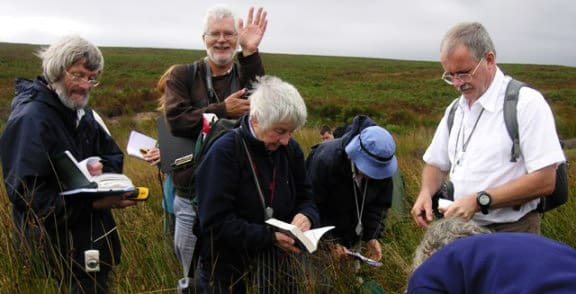John Swindells
GiGL’s Board of Directors are central to our work and our success. Their commitment and expertise helps guide GiGL and keeps us moving forward and developing. Directors are on the front line of biodiversity and open space work in the capital. They are GiGL service users and contribute to our data banks, as well as serving as ambassadors for GiGL.
John Swindells is a long-standing member and former President of the London Natural History Society, chair of the Wild Flower Society and a Council member of the Botanical Society of Britain and Ireland. He has a particular interest in urban wild plants.

John Swindells with a group of BSBI members on the Long Mynd in Shropshire.
Town or countryside?
Countryside, but I have enjoyed living in inner London for the last 37 years.
Summer or winter?
Autumn.
Early bird or night owl?
Night owl.
Outdoor or indoors?
Outdoors, but I prefer to sleep indoors.
Plants or animals?
Plants, but I also like butterflies.
We know you’re an expert plant recorder. What is it about plants that most interests you?
More than the plants themselves, it is the challenge of understanding the factors that influence their habits and habitats.
Is there an animal group would you like to be able to better identify?
If I could only choose an animal group it would be grasshoppers and crickets. If I could choose a plant group it would be grasses. A better microscope would help with these.
What is your favourite Greater London open space and why?
I’d like to choose two; Oxleas Wood in Greenwich and Mudchute Park and Farm in Tower Hamlets. Oxleas Wood is a remnant of ancient woodland, perhaps the nearest to central London and Mudchute Farm, in which I must declare an interest as a trustee. It is an entirely human-influenced open space with a wide variety of plant and animal species, both native and introduced.
Who or what inspires you to keep recording?
Ultimately, if it doesn’t sound too pompous, I’d say I am inspired by adding to the sum of human knowledge. It gives me a thrill to find a species in a new place, especially if that is an unexpected place, or to re-find a species in a place where it was thought to be extinct.
How did you first get involved with GiGL?
In January 2005, the London Natural History Society was looking for a representative to serve on GiGL’s Steering Group and as I was then working on a dissertation for an MSc in Biological Recording it seemed like a good idea.
As a long standing London recorder, what do you think are the biggest challenges and opportunities for London’s biodiversity, and how can GiGL help?
The biggest challenges must surely be the increasing human population of London and the consequent rising demand for housing and services; together with the success of London as a commercial and financial centre leading to significant and increasing building development. In the East End where I live recent developments, especially of brownfield sites, have led to a reduction in biodiversity. On the other hand, more sympathetic management of public open spaces and mitigation elements in new building developments (especially, for example, living roofs) have enhanced biodiversity potential. The All London Green Grid is an example of a planning-related initiative that could lead to greater biodiversity through the linking of existing green spaces.
As a recorder, I value GiGL because it holds and makes available data across the full range of plant, animal and fungal species where most of the national recording schemes deal with single taxonomic groups. GiGL’s huge holding of data is available to inform planning decisions, to assist local authorities and other major land owners in the sympathetic management of those holdings to benefit biodiversity in the capital, and to individual researchers interested in the plant and animal species that live alongside us and enhance our environment.
